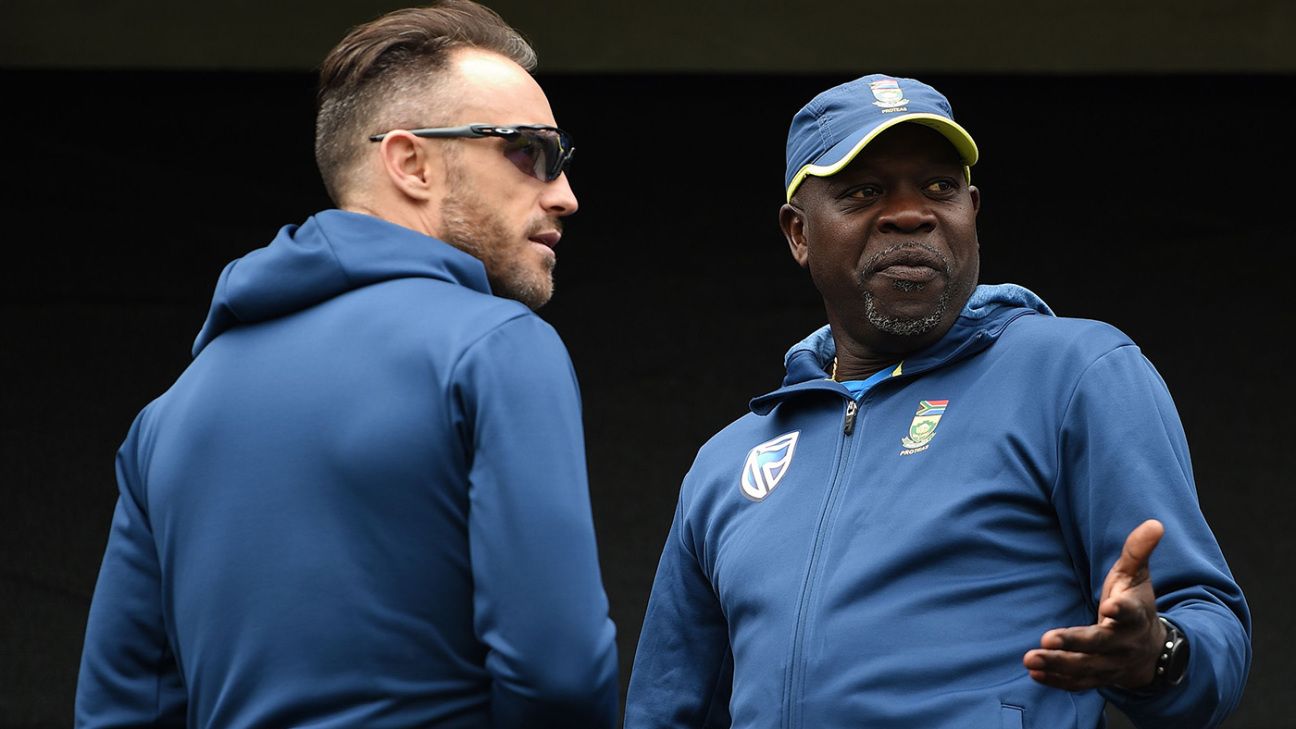The messy fallout from South Africa’s disastrous World Cup campaign is now out in the open. Various internal communications leaked to the media over the last few days have hinted at a somewhat fractious end to the tenures of both Ottis Gibson, the head coach, and Mohammad Moosajee, the long-standing team doctor and manager.
Over the weekend, the entire coaching staff of the men’s team were let go amid a major restructuring exercise. It has since emerged that Cricket South Africa went back on an agreement – in principle at least – to extend Gibson’s contract until 2021.
At a CSA board meeting in February the extension was agreed, and an independent director was asked to redraft a new contract. The specifics of the contract, however, appear to have been a stumbling block.
“I first spoke with Ottis, and I said I would like to suggest that the board have a look at your contract, with a possible extension,” CSA chief executive Thabang Moroe explained at a press conference on Tuesday. “Ottis responded by saying that he would more or less look at being employed until 2021, and that’s what I should suggest to the board. I did suggest that to the board. The board deliberated on that.
“What the board essentially said to me, to quote verbatim, was, ‘we’re agreeing that you can go ahead and extend the coach’s contract, subject to him agreeing to key specific pointers in his contract changing’. Part of that being EPG [transformation targets], part of that being communication, part of that being performance. We went back to the coach, together with the now acting Director of Cricket and communicated that to the coach, of which he said he could not immediately agree until he saw what his contract looked like.”
It has emerged since that the board was concerned at the team missing their transformation targets for the second year in a row, forcing them to enact a policy which would give Moroe final sign-off on team selections and enhanced ability to ensure targets were being met. However, that decision was made without taking the views of Gibson or selection convenor Linda Zondi, resulting in further friction.
“Now, that meeting is essentially the same meeting where this policy of selection was spoken of,” Moroe continued. “Obviously it is well documented now in the media that the coach was not really be happy about the board now wanting to activate this policy.”
This forced the board to quickly backtrack. It was subsequently reported that transformation targets wouldn’t apply at the World Cup. “The perception that was already put out there was that the board, together with the CEO, was intending to interfere in selection, which wasn’t true,” Moroe said. “To dispel such notions or rumours, we just simply put the policy on ice.
“Similarly, with Ottis not agreeing, that’s one of the decisions that emanated from that meeting. That caused the board to say, ‘listen because the coach is not agreeable to a few things that we’re already saying, lets rather put his contract on ice as well’ and judge him the same way we said we would from the first, which is his performances at the World Cup’.”
The result was that Gibson went to the World Cup unsure of his long-term future as South Africa’s coach. There were more tensions yet, over the participation of several key players in the IPL, which preceded the World Cup. Gibson wanted his players back early, but Moroe is understood to have not forced the issue with the BCCI for the worry of potential financial consequences.
According to reports from leaked communication, Moroe confirmed to Gibson that it had been decided at an April 6 board meeting that CSA wouldn’t be able to financially compensate the players for shortened IPL gigs, which is said to have further disappointed Gibson.
The outgoing South African coach wasn’t the only member of the team management left disgruntled by events leading up to South Africa’s reshuffle. It has also been revealed that there was an attempt to remove Moosajee from his position in September last year. However, Gibson and captain Faf du Plessis are said to have met CSA president Chris Nenzani to secure his position.
Last week, ahead of CSA’s board meeting, Moosajee informed the board that he didn’t want to continue, apparently also unhappy that he had been removed from CSA’s Exco, a senior executives committee on which Moosajee had been able to directly represent the team he managed. The Exco forms part of the chief executives committee, on which sit both CSA and South African Cricketers Association chief executives.
The subject of CSA’s strained relationship with SACA was also a talking point at Tuesday’s press conference. SACA launched legal action against CSA on the eve of the World Cup over the restructuring of domestic cricket and Moroe said CSA are seeking to avert litigation with SACA by meeting with them to iron out any differences.
“It would be irresponsible for me to say no, we’re willing to go to court at all costs,” Moroe said. “If we have to we will, to defend our views as CSA. But yes, it is our hope that we don’t go to court. At the end of the day, we are family with SACA and I’d like to think that whatever differences might be on the table, as family we should be able to sit around a table and thrash out those differences and essentially agree to move on. Whether the one party might still be unhappy to a certain extent or not, that should be irrelevant.”

